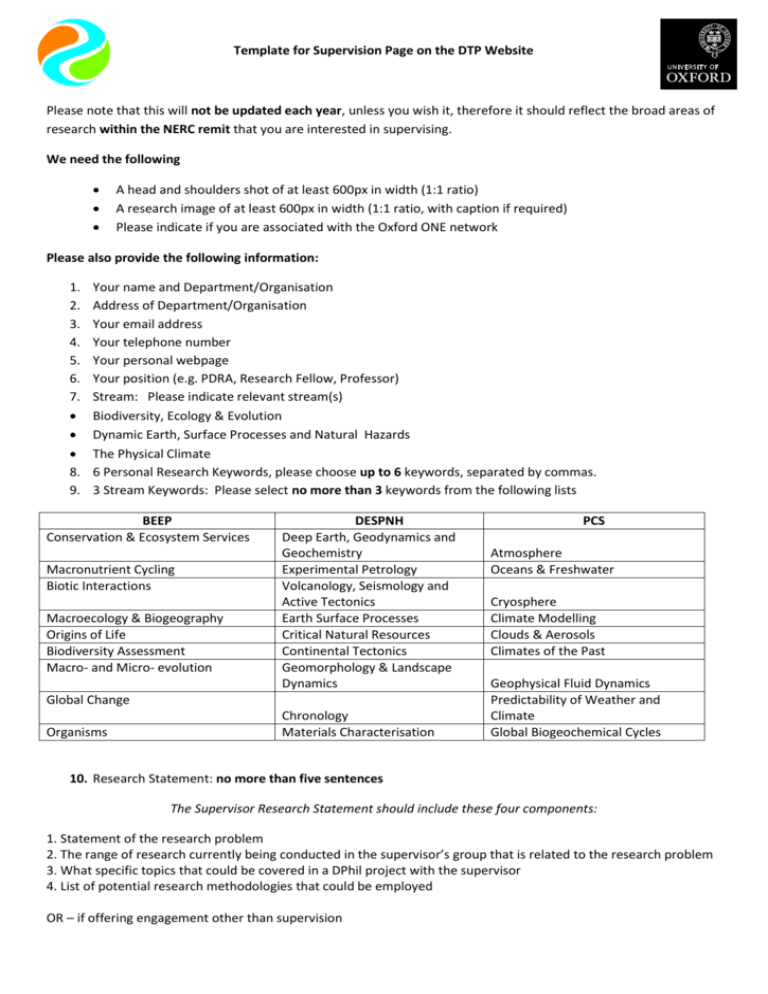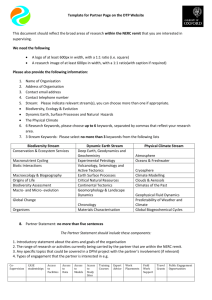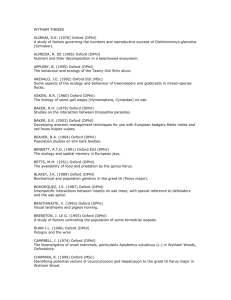Partner Supervision Page Template
advertisement

Template for Supervision Page on the DTP Website Please note that this will not be updated each year, unless you wish it, therefore it should reflect the broad areas of research within the NERC remit that you are interested in supervising. We need the following A head and shoulders shot of at least 600px in width (1:1 ratio) A research image of at least 600px in width (1:1 ratio, with caption if required) Please indicate if you are associated with the Oxford ONE network Please also provide the following information: 1. 2. 3. 4. 5. 6. 7. 8. 9. Your name and Department/Organisation Address of Department/Organisation Your email address Your telephone number Your personal webpage Your position (e.g. PDRA, Research Fellow, Professor) Stream: Please indicate relevant stream(s) Biodiversity, Ecology & Evolution Dynamic Earth, Surface Processes and Natural Hazards The Physical Climate 6 Personal Research Keywords, please choose up to 6 keywords, separated by commas. 3 Stream Keywords: Please select no more than 3 keywords from the following lists BEEP Conservation & Ecosystem Services Macronutrient Cycling Biotic Interactions Macroecology & Biogeography Origins of Life Biodiversity Assessment Macro- and Micro- evolution DESPNH Deep Earth, Geodynamics and Geochemistry Experimental Petrology Volcanology, Seismology and Active Tectonics Earth Surface Processes Critical Natural Resources Continental Tectonics Geomorphology & Landscape Dynamics Global Change Organisms Chronology Materials Characterisation PCS Atmosphere Oceans & Freshwater Cryosphere Climate Modelling Clouds & Aerosols Climates of the Past Geophysical Fluid Dynamics Predictability of Weather and Climate Global Biogeochemical Cycles 10. Research Statement: no more than five sentences The Supervisor Research Statement should include these four components: 1. Statement of the research problem 2. The range of research currently being conducted in the supervisor’s group that is related to the research problem 3. What specific topics that could be covered in a DPhil project with the supervisor 4. List of potential research methodologies that could be employed OR – if offering engagement other than supervision 1. Statement about your area of expertise 2. Outline of the type of engagement opportunities you offer 3. Any potential skills or experience that could be acquired by the student 4. Any ways in which the student might be of assistance to the partner (Please see below for examples of research statements.) Good examples from 2014-2015 Yadvinder Malhi (School of Geography & the Environment) There is much interest in how sensitive or resilient tropical forests are to climate change, and in particular drought. The student will be part of a research group that is conducting pioneering research on the functioning of both intact and human-modified tropical forests around the world. The details of any DPhil project would be defined in discussion with the student, but are likely to entail a significant ecological or ecophysiological component of fieldwork in one or more tropical sites, and could also involve computational modelling of tropical forest environments, airborne and satellite remote sensing, and laboratory or field experiments. Potential field areas include Peru, Brazil, Ghana, Gabon, Ethiopia and Malaysia. Michael Petraglia (Archaeology) Major questions in human evolutionary studies pertain to how climate change influenced the survival, dispersal and adaptations of hominins. Environmental changes in the Saharo-Arabian zone, in particular, are thought to have shaped the movements of hominins ‘Out of Africa’ and into Eurasia. The DPhil student will be part of an international, interdisciplinary research group conducting pioneering field work in the Arabian peninsula. The student will be generally engaged in examining and documenting the relationship between environmental change and archaeological sites. The details of any DPhil project will be defined in discussion with the student, but there are a number of potential avenues of research, including use of climate models to simulate past environments, application of chronometric methods to examine shifts in environments and hominin presence, study of sedimentary, isotopic and palaeobotanical records from lakes, and study of palaeontological finds.








